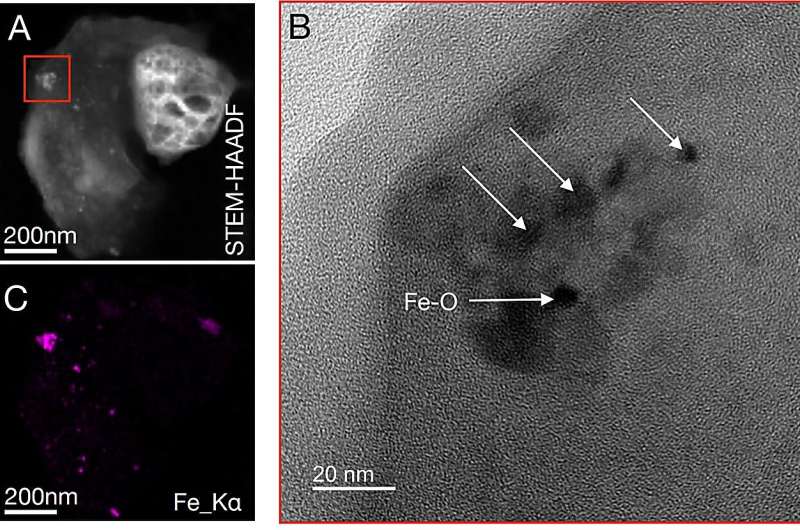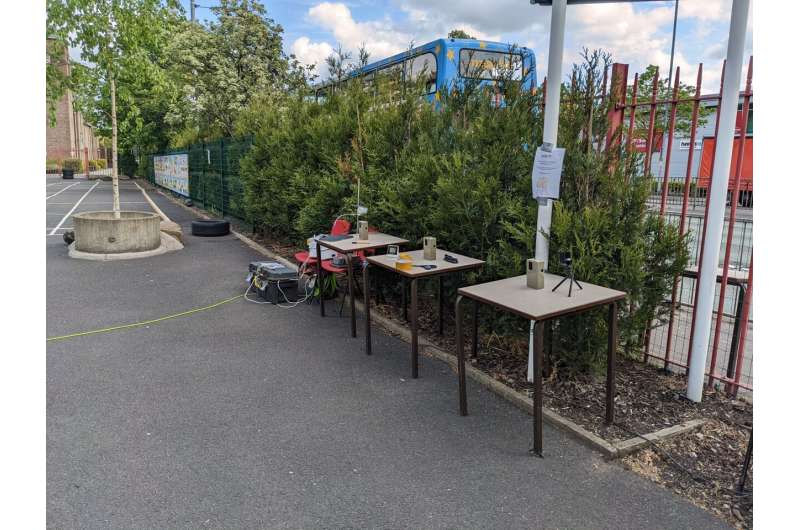This article has been reviewed according to Science X's editorial process and policies. Editors have highlighted the following attributes while ensuring the content's credibility:
fact-checked
peer-reviewed publication
trusted source
proofread
Roadside hedges can reduce harmful ultrafine particle pollution around schools

A new study led by Cambridge University confirms that planting hedges between roadsides and school playgrounds can dramatically reduce children's exposure to traffic-related particle pollution.
The research, a collaboration with Lancaster University, found that hedges can act as protective barriers against air pollution from major city roads by soaking up significant quantities of harmful particles emitted by traffic. The study is published in the journal Science of The Total Environment.
The researchers applied a new type of pollution analysis, using magnetism to study particles trapped by a hedge separating a major 6-lane road from a primary school in Manchester, UK. They found that the hedge was especially successful in removing ultrafine particle pollution, which can be more damaging to health.
"Our findings show that hedges can provide a simple, cheap and effective way to help reduce exposure to local sources of pollution," said lead author Hassan Sheikh from Cambridge's Department of Earth Sciences.
The new study differs from conventional air pollution studies because the researchers specifically measured magnetic particles, which originate from vehicle exhaust and the wearing of brake pads and tires. That allowed them to distinguish local traffic pollution from other sources of air pollution.
In England alone, epidemiological studies estimate that 26,000 to 38,000 deaths and thousands of NHS hospital admissions are linked to dust-like particles carried in air pollution—much of which is generated by heavy traffic in urban environments.
This particle pollution—or particulate matter—is made up of a variety of chemical compounds, metals and other materials, some of which are toxic. The bigger particles (which are still tiny) measure less than 10 microns in diameter (called PM10) and are easily inhaled. Finer particles of less than 2.5 microns across (PM2.5) can penetrate deeper into the lungs and are small enough to enter the bloodstream.
Children attending schools next to busy roads are especially vulnerable to the effects of air pollution because their airways are still developing and they breath faster than adults.
Sheikh and the team studied magnetic particles captured by a western red cedar "tredge" (trees managed at head-height) which was previously installed outside St Ambrose Primary School as part of a trial led by Lancaster University.
"Western red cedar does a great job in 'capturing ' particulate pollution because it has abundant, fine, evergreen leaves into which airborne particles bump and then settle from the roadside air," said study co-author Professor Barbara Maher from the University of Lancaster who led the previous research.

Sheikh and the team measured particles of varying sizes on the leaves of the tredge and used air filters to measure particle abundance at intervals downwind toward the school playground.
They also developed a new experiment that used a tracer gas to understand how ultrafine particles (measuring less that 2.5 microns) moved through and were trapped by the tredge.
Their results revealed that there was a substantial reduction in particle pollution downwind of the tredge. "The tredge acts as a permeable barrier, intercepting and capturing particles effectively on its leaves," said Sheikh.
In the school playground, 30 meters from the road, they measured a 78% decrease in PM10 relative to roadside air.
They noticed that this removal was even more efficient for ultrafine PM2.5 particles. "What was remarkable was just how efficiently the tredge hoovered up the very finest particles," said senior author Professor Richard Harrison, also from Cambridge's Department of Earth Sciences. They measured an 80% reduction in the ultrafine particles just behind the tredge.
They think the ultrafine particles are preferentially filtered out by the tredge because they have a higher likelihood of being captured on the ridged surfaces of the red cedar leaves than coarser particles.
However, they did note a slight uptick in levels of magnetic PM2.5 in the playground, although they were still 63% below roadside air. "The ultrafine particles were very effectively removed, but this shows that some air still goes over or around the tredge," said Sheikh. Less is currently known about how particulate matter moves and disperses at this higher level, where air mixes around buildings and trees.
"That means the design and placement of tredges near playgrounds and schools should be carefully considered so that their ability to soak up particles can be used to maximum effect," said Harrison.
Cllr Tracey Rawlins, Executive Member for Environment for Manchester City Council, said, "We were keen to be part of this study as Manchester seeks to embrace innovation in our efforts to become a greener city with cleaner air and tackle climate change.
"The findings underline the contribution which nature-based innovations can make to rising to that challenge. We look forward to delivering more green screens as well as many trees at school sites, complementing our education climate change strategy," said Rawlins.
Previously, Sheikh and Harrison used their new magnetic analysis to identify high levels of ultrafine particles polluting the London Underground. They now plan on working with colleagues at the MRC Toxicology Unit in Cambridge to find out what happens when cells are exposed to this type of ultrafine particle pollution.
More information: H.A. Sheikh et al, Efficacy of green infrastructure in reducing exposure to local, traffic-related sources of airborne particulate matter (PM), Science of The Total Environment (2023). DOI: 10.1016/j.scitotenv.2023.166598
Journal information: Science of the Total Environment
Provided by University of Cambridge





















